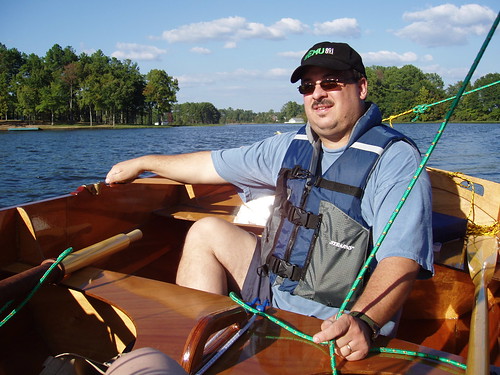
At this stage, the instructions call for two coats of unthickened epoxy on the entire exterior of the hull. The exterior sides of the #1 strakes to this point have not received any epoxy coating, and the layer of fiberglass on the bottom panel still requires that the weave be filled. A good session of sanding preceded the first coat of epoxy. I made sure to smooth down all the filled stitch holes, as well as some little "spines" of cabosil-epoxy that had wicked up underneath some of the stitches as the seams were glued. When the wires were removed, these little ridges remained and had to be sanded away. After a tedious period of sanding, I mixed up some unthickened epoxy (it turned out that 14 pumps were necessary to cover the whole hull and transoms) and rolled it on. I am eyeing my epoxy supply with a little apprehension: after the coating of the hull, no tasks remain that require large batches to be mixed. Even so, plenty of little things remain that require epoxy, like coating of rudder and daggerboard parts, gluing the motor pad, filleting seats and knees, and the like. I have been careful to be economical with what was supplied with the kit, but I hope what remains will hold out.
Total hours 61.25.
 At this stage, the instructions call for two coats of unthickened epoxy on the entire exterior of the hull. The exterior sides of the #1 strakes to this point have not received any epoxy coating, and the layer of fiberglass on the bottom panel still requires that the weave be filled. A good session of sanding preceded the first coat of epoxy. I made sure to smooth down all the filled stitch holes, as well as some little "spines" of cabosil-epoxy that had wicked up underneath some of the stitches as the seams were glued. When the wires were removed, these little ridges remained and had to be sanded away. After a tedious period of sanding, I mixed up some unthickened epoxy (it turned out that 14 pumps were necessary to cover the whole hull and transoms) and rolled it on. I am eyeing my epoxy supply with a little apprehension: after the coating of the hull, no tasks remain that require large batches to be mixed. Even so, plenty of little things remain that require epoxy, like coating of rudder and daggerboard parts, gluing the motor pad, filleting seats and knees, and the like. I have been careful to be economical with what was supplied with the kit, but I hope what remains will hold out. Total hours 61.25.
At this stage, the instructions call for two coats of unthickened epoxy on the entire exterior of the hull. The exterior sides of the #1 strakes to this point have not received any epoxy coating, and the layer of fiberglass on the bottom panel still requires that the weave be filled. A good session of sanding preceded the first coat of epoxy. I made sure to smooth down all the filled stitch holes, as well as some little "spines" of cabosil-epoxy that had wicked up underneath some of the stitches as the seams were glued. When the wires were removed, these little ridges remained and had to be sanded away. After a tedious period of sanding, I mixed up some unthickened epoxy (it turned out that 14 pumps were necessary to cover the whole hull and transoms) and rolled it on. I am eyeing my epoxy supply with a little apprehension: after the coating of the hull, no tasks remain that require large batches to be mixed. Even so, plenty of little things remain that require epoxy, like coating of rudder and daggerboard parts, gluing the motor pad, filleting seats and knees, and the like. I have been careful to be economical with what was supplied with the kit, but I hope what remains will hold out. Total hours 61.25.


1 Comments:
Peter,
I agree about the amount of epoxy. I was starting to get a little nervous about the amount supplied (3 gallons total), so I did some quick math. I added up every mention of epoxy that is in the manual. There are some places where CLC doesn't give an amount to mix, there I just estimated based on other parts and my limited experience.
All said and done, I come up with an approximate need for 237oz (3.7 gallons). A deficit of 45 oz.
I'm very strongly thinking about ordering some more...
Let me know what you think of my numbers and if they jive with how much you think you'll need.
-Erik
Post a Comment
<< Home